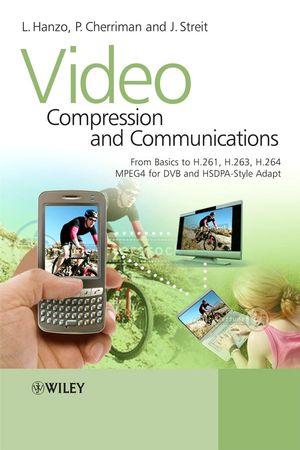Video Compression and Communications: From Basics to H.261, H.263, H.264, MPEG4 for DVB and HSDPA-Style Adaptive Turbo-TransceiversISBN: 978-0-470-51849-6
Hardcover
702 pages
October 2007, Wiley-IEEE Press
 This is a Print-on-Demand title. It will be printed specifically to fill your order. Please allow an additional 10-15 days delivery time. The book is not returnable.
|
||||||
About the Authors xvii
Other Wiley and IEEE Press Books on Related Topics xix
Preface xxi
Acknowledgments xxiii
1 Introduction 1
1.1 A Brief Introduction to Compression Theory 1
1.2 Introduction to Video Formats 2
1.3 Evolution of Video Compression Standards 5
1.4 Video Communications 15
1.5 Organization of the Monograph 17
I Video Codecs for HSDPA-style Adaptive Videophones 19
2 Fractal Image Codecs 21
2.1 Fractal Principles 21
2.2 One-dimensional Fractal Coding 23
2.3 Error Sensitivity and Complexity 32
2.4 Summary and Conclusions 33
3 Low Bitrate DCT Codecs and HSDPA-style Videophone Transceivers 35
3.1 Video Codec Outline 35
3.2 The Principle of Motion Compensation 37
3.3 Transform Coding 51
3.4 The Codec Outline 58
3.5 Initial Intra-frame Coding 60
3.6 Gain-controlled Motion Compensation 60
3.7 TheMCER Active/Passive Concept 61
3.8 Partial Forced Update of the Reconstructed FrameBuffers 62
3.9 The Gain/Cost-controlled Inter-frame Codec 64
3.10 The Bit-allocation Strategy 66
3.11 Results 67
3.12 DCT Codec Performance under Erroneous Conditions 70
3.13 DCT-based Low-rate Video Transceivers 72
3.14 System Performance 80
3.15 Summary and Conclusions 89
4 Very Low Bitrate VQ Codecs and HSDPA-style Videophone Transceivers 93
4.1 Introduction 93
4.2 The Codebook Design 93
4.3 The Vector Quantizer Design 95
4.4 Performance under Erroneous Conditions 105
4.5 VQ-based Low-rate Video Transceivers 107
4.6 System Performance 113
4.7 Joint Iterative Decoding of Trellis-based Vector-quantized Video and TCM 118
4.8 Summary and Conclusions 136
5 Low Bitrate Quad-tree-based Codecs and HSDPA-style Videophone Transceivers 139
5.1 Introduction 139
5.2 Quad-tree Decomposition 139
5.3 Quad-tree Intensity Match 142
5.4 Model-based Parametric Enhancement 148
5.5 The Enhanced QTCodec 153
5.6 Performance and Considerations under Erroneous Conditions 154
5.7 QT-codec-based Video Transceivers 158
5.8 QT-based Video-transceiver Performance 162
5.9 Summary of QT-based Video Transceivers 165
5.10 Summary of Low-rate Video Codecs and Transceivers 166
II High-resolution Video Coding 171
6 Low-complexity Techniques 173
6.1 Differential Pulse Code Modulation 173
6.2 Block Truncation Coding 177
6.3 Subband Coding 183
6.4 Summary and Conclusions 202
7 High-resolution DCT Coding 205
7.1 Introduction 205
7.2 Intra-frame Quantizer Training 205
7.3 Motion Compensation for High-quality Images 209
7.4 Inter-frame DCT Coding 215
7.5 The Proposed Codec 224
7.6 Summary and Conclusions 235
III H.261, H.263, H.264, MPEG2 and MPEG4 for HSDPA-style Wireless Video Telephony
and DVB 237
8 H.261 for HSDPA-style Wireless Video Telephony 239
8.1 Introduction 239
8.2 TheH.261VideoCoding Standard 239
8.3 Effect of Transmission Errors on theH.261Codec 253
8.4 A Reconfigurable Wireless Videophone System 272
8.5 H.261-basedWireless Videophone System Performance 283
8.6 Summary and Conclusions 293
9 Comparative Study of the H.261 and H.263 Codecs 295
9.1 Introduction 295
9.2 TheH.263CodingAlgorithms 297
9.3 Performance Results 318
9.4 Summary and Conclusions 335
10 H.263 for HSDPA-style Wireless Video Telephony 339
10.1 Introduction 339
10.2 H.263inaMobileEnvironment 339
10.3 Design of an Error-resilient Reconfigurable Videophone System 343
10.4 H.263-based Video System Performance 352
10.5 Transmission Feedback 367
10.6 Summary and Conclusions 376
11 MPEG-4 Video Compression 379
11.1 Introduction 379
11.2 OverviewofMPEG-4 380
11.3 MPEG-4: Content-based Interactivity 387
11.4 Scalability of Video Objects 396
11.5 Video Quality Measures 398
11.6 Effect of Coding Parameters 400
11.7 Summary and Conclusion 404
12 Comparative Study of the MPEG-4 and H.264 Codecs 407
12.1 Introduction 407
12.2 TheITU-TH.264Project 407
12.3 H.264VideoCodingTechniques 408
12.4 H.264SpecificCodingAlgorithm 410
12.5 Comparative Study of theMPEG-4 and H.264 Codecs 425
12.6 Performance Results 428
13 MPEG-4 Bitstream and Bit-sensitivity Study 437
13.1 Motivation 437
13.2 Structure of Coded Visual Data 437
13.3 Visual Bitstream Syntax 440
13.4 Introduction to Error-resilient Video Encoding 441
13.5 Error-resilient Video Coding in MPEG-4 441
13.6 Error-resilience Tools in MPEG-4 443
13.7 MPEG-4Bit-sensitivityStudy 448
13.8 Chapter Conclusions 457
14 HSDPA-like and Turbo-style Adaptive Single- and Multi-carrier Video Systems 459
14.1 Turbo-equalized H.263-based Videophony for GSM/GPRS 459
14.2 HSDPA-style Burst-by-burst Adaptive CDMA Videophony: Turbo-coded Burst-by-burst Adaptive Joint Detection CDMA and H.263-based Videophony 472
14.3 Subband-adaptive Turbo-coded OFDM-based Interactive Videotelephony 485
14.4 Burst-by-burst Adaptive Decision Feedback Equalized TCM, TTCM, and BICM for H.263-assistedWireless Videotelephony 506
14.5 Turbo-detected MPEG-4 Video Using Multi-level Coding, TCM and STTC 526
14.6 Near-capacity Irregular Variable Length Codes 543
14.7 Digital Terrestrial Video Broadcasting for Mobile Receivers 558
14.8 Satellite-based Video Broadcasting 601
14.9 Summary and Conclusions 622
14.10WirelessVideoSystemDesignPrinciples 623
Glossary 625
Bibliography 635
Index 659
Author Index 667



